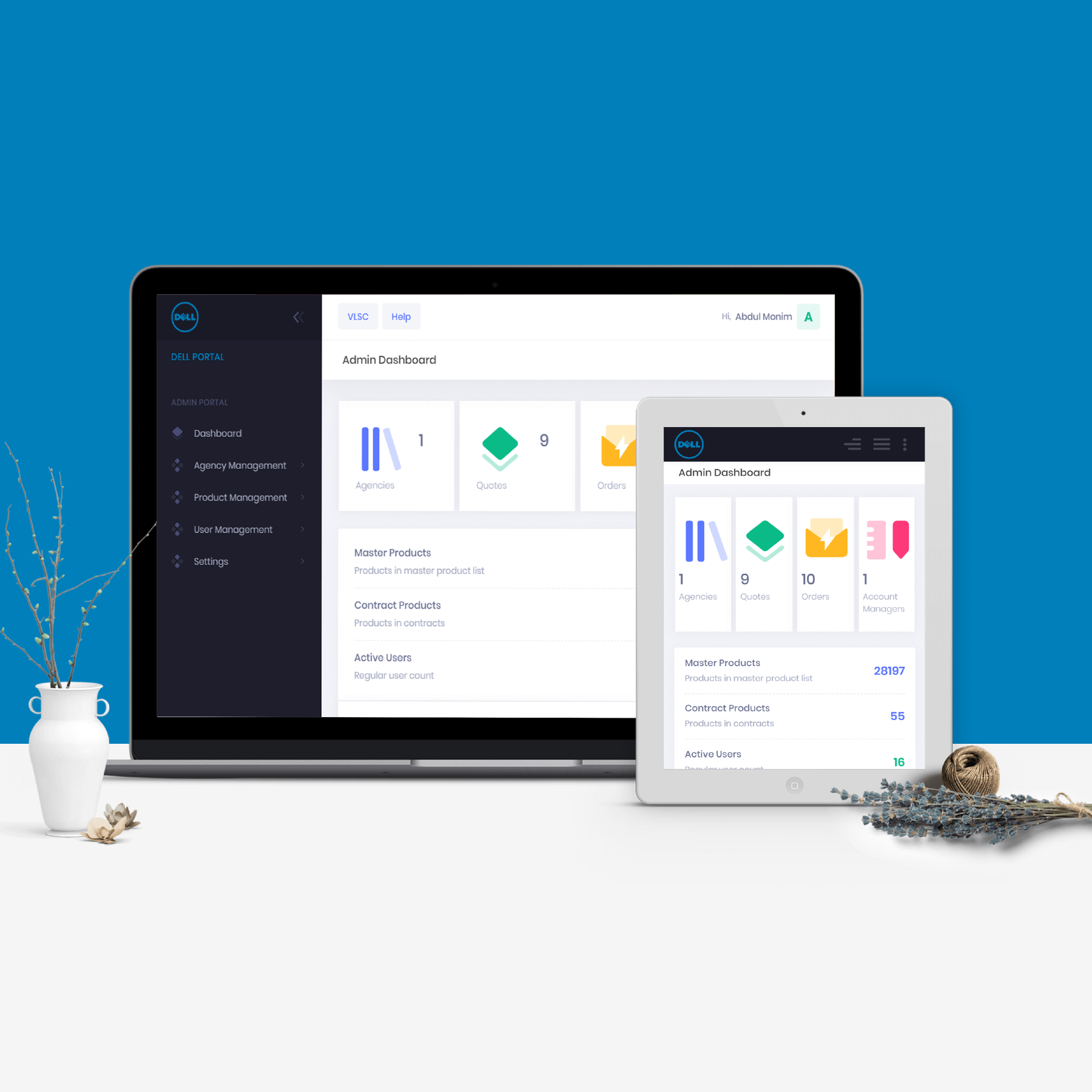The client needs a portal that’s feasible to use for purchasing and managing licenses. They want a system for ordering and license management that makes purchasing software easier. The portal should help customers to control and see their license needs better, with features like reporting. The client also wants the system to have budget planning capabilities. Additionally, they need a portal access feature and all users must register to use it.
- Agency admin dashboard: This dashboard allows the admin to set up different bureaus, users, and product groups, giving them control over who can access and choose different products.
- Dell admin dashboard: From this dashboard, Dell admin can configure users, upload/add/edit products and pricing, also process customer orders.
- Product catalog & Shopping cart: User can avail a streamlined purchasing experience of Microsoft licenses through the online shopping cart.
- Quote & Order Processing: A quoting tool is enabled for the budgetary planning and customer can experience the facilities of placing order and tracking it.
- Report: This feature generates structured reports, providing a detailed overview of order details, history, licensing, pricing, and product information for easy review.
- Integration Complexity: Making this portal smoothly connected with Microsoft's tools, especially VLSC, was difficult.
- User access management: Building a structured user access control was a matter of concern.
- Security concerns: Strong measures needed to protect important licensing info.
- Real-time reporting: Providing accurate and timely reporting on purchasing activities demanded advanced data analytics.
Project Description
The Microsoft License Management Portal for Dell is like a helpful tool for Dell admins to easily handle software purchases. The project focuses on making the process smoother by helping with software purchases and improving overall ease of use. It includes features for online ordering and managing licenses. It also helps administrator to better control and see their license needs. For budget planning, there’s a tool to create a document for ordering needs. The portal is secured and allows admins to control who can access it. Moreover, it comes with reporting features so admins can keep track of what they’re buying
Client Requirements
Features
- Agency admin dashboard: This dashboard allows the admin to set up different bureaus, users, and product groups, giving them control over who can access and choose different products.
- Dell admin dashboard: From this dashboard, Dell admin can configure users, upload/add/edit products and pricing, also process customer orders.
- Product catalog & Shopping cart: User can avail a streamlined purchasing experience of Microsoft licenses through the online shopping cart.
- Quote & Order Processing: A quoting tool is enabled for the budgetary planning and customer can experience the facilities of placing order and tracking it.
- Report: This feature generates structured reports, providing a detailed overview of order details, history, licensing, pricing, and product information for easy review.
Project Approach & Result
The client wanted a solution for managing the license portal with other selective features like: placing order and tracking, generating structured reports containing various information. Our approach began with a thorough understanding of the client’s requirements, and we crafted a well-defined plan with clear objectives and timelines.
Our dedicated team of developers employed the design architecture including the application architecture, database designing and environment setup. The developers gradually developed all the required features including Agency dashboard, Dell admin dashboard, product catalog, order and tracking functionalities, shopping cart, report generating functionalities and others. To facilitate user interaction, we developed the application, allowing admins as well as users to avail the features.
Despite difficulties along the way, we successfully implemented a solution that met the client’s expectations within the timeframe specified. Testing was carried out to guarantee that the system works flawlessly. Finally, we created a management portal that properly suited the client’s needs for managing the purchase procedures of licenses.
Challenges
- Integration Complexity: Making this portal smoothly connected with Microsoft’s tools, especially VLSC, was difficult.
- User access management: Building a structured user access control was a matter of concern.
- Security concerns: Strong measures needed to protect important licensing info.
- Real-time reporting: Providing accurate and timely reporting on purchasing activities demanded advanced data analytics.
Dell Microsoft License Management Portal
The Museum Display Software provides a centralized digital library system containing information of Bangladesh Army’s all field operations since 1971. This software also works as a content management system to enable the feature of creating and maintaining the data entries.
It captures operational content and data in multiple formats and also provides a secure access mechanism to prevent unauthorized access of sensitive information. Along with that, Museum Display Software allows to develop new contents or authorize existing contents for public consumption which is located at the Bangabandhu Military Museum.
Client Requirements
The client wanted a system that can centralize all the information in a digital library. Along with that, this can be also utilized as a content management system having a feature of entering data in various format (i.e. text, video, photograph, sound, data tables) and managing it with a secured mechanism. The client also wanted to build a security system within the software which can avoid unauthorized access.
As per the requirements, this system also has the capability to authorize existing contents which will help to maintain the accuracy of information.
Features
-
-
- User Access: Users can access this system according to different tiers. This system allows specific users to have access in specific modules.
- Content Editing & Management: Users with the right access can effortlessly upload, create, save, maintain, and integrate content in various formats. This system ensures that the content is readily available whenever it is needed.
- Content Security & Separation: This system provides robust content security features that also can separate sensitive content with ease. Users can have the facility to see the contents without any disruption into the system as it ensures secured access.
- Content Storage and Distribution: This system provides secured content storage and efficient distribution to safeguard all content whether it’s confidential data or public-facing material.
- Dashboard & Utilities: This system provides multiple dashboards and utilities tailored to different user types which helps to track, manage, and handle content-related tasks with ease.
- Audit Trails: This system is integrated with robust audit trails at every level, providing system-generated logs of all actions. From user management to content changes, the audit trail captures it all.
-
Project Approach & Result
The Museum display system demands a lot of works as it provides a centralized digital library functionality as well as a content management system. The client wanted a seamless display system for that to handle operational materials and data with the utmost security, supporting a diverse range of formats.
As a result, our journey began with a deep understanding of your unique requirements to circulate the frameworks and approaches. We meticulously planned the project, mapping out milestones, timelines, resource allocation to ensure transparency and success. We designed an architecture that not only ensures scalability and security but also preserves historical data. Our user-friendly interfaces cater to content managers, historians, and museum staff, making content management, search effortlessly.
Our development phase was executed with precision. The developer team leveraged industry-standard CMS architecture, employing programming languages such as Python, JavaScript, and the Angular Framework. They also established a rigorous multi-factor authentication process and encryption standards to protect valuable content.
From starting with requirement analysis to the phase of deploying this system, the journey was challenging enough, but our unwavering dedication and teamwork prevailed. We were able to deliver a solution that met the client’s needs within the defined timeline and budget. Before handing it over to the client, our quality assurance team rigorously tested every aspect to ensure it operated flawlessly.
Challenges
-
-
- User Experience: Implementing an engaging user experience was a concern. This system creates a balance between encouraging exploration and learning the gravity of military history. So, our developers created tailor access so that users learn about the content by not creating any disruption into the system.
- Ensuring Content Accuracy: Maintaining the accuracy of historical information was a big concern. So, our developer created the system to recognize the importance of safeguarding the museum’s reputation and credibility. We performed rigorous checking to guarantee that every piece of historical information is accurate before it’s shared with the world.
- Managing Sensitive Content: Managing the sensitive and potentially historical topics is surely a challenge. Our developers skillfully navigated this, by striking a balance between historical accuracy and the sensitivity of these topics.
- Copyright & Licensing: The legal and logistical challenges of maintaining copyright procedures were taken sincerely. Obtaining the necessary permissions for using historical images, documents, and other media was a huge task, but our team handled it with professionalism and dedication.
-
Task
The objective of this project is to develop a centralized digital library system of Bangladesh Army’s all field operations since 1971 and provide a content management system to enable the creation and maintenance of entries to the digital library system. The delivered system will capture operational content and data in multiple formats (i.e. text, video, photograph, sound, data tables) and archive them in a highly secure fashion.
-
Date
November 26, 2020
-
Skills
Python, AWS, Angular, Docker
-
Client
Microsoft
Share project



 We’d love to hear from you. We are available here to answer your queries.
We’d love to hear from you. We are available here to answer your queries.